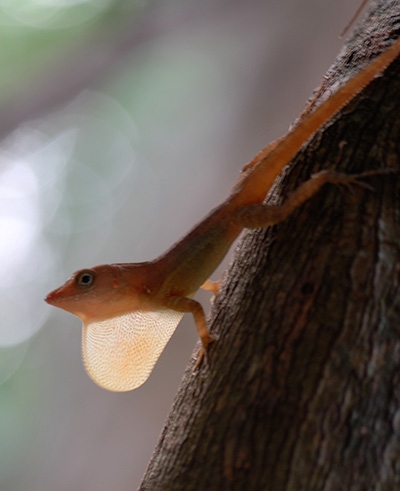Leo Fleishman, William D. Williams Professor of Biological Sciences (With Brianna Ogas '12, David Steinberg, Duke University; Manuel Leal, University of Missouri)
Want to stand out a little more?
Get noticed?
Try making yourself glow, it seems to work for the Jamaican gray anole. Okay, so Anolis lineatopus doesn’t actually luminesce, it only appears to, but the principle still holds, as Leo Fleishman and his colleagues reported recently in the journal of Functional Ecology.
Male lizards of this species, which reach three to six inches in length, have colorful throat fans (called dewlaps) that they use to attract mates. The animals enhance the look of their already vibrant fans with an optical illusion.
Lizards, and people, are used to seeing things like tree trunks, dirt and rocks that reflect light and appear pretty dull, Fleishman explained. But because the anoles have translucent dewlaps, light passes through them when the fans are extended. As a result, the skin under the lizard’s chin seems to glow.
And this “glow” helps the reptiles stand out in their shady home—but not necessarily because they’re creating contrast with the generally darker environment. There are, after all, plenty of places in any forest where equally bright things, like sunshine, radiate through the vegetation.
“When light is transmitted through the dewlap, it makes the color easier to distinguish from other colors in the environment,” Fleishman said.
In other words, the sunset-orange that male lizard’s sporting is clearer than similar hues—maybe of that flower beside him. And this means he’s less likely to get overlooked by the females in the neighborhood.
Learn more about Fleishman's work, and see an anole's dewlap in action.

